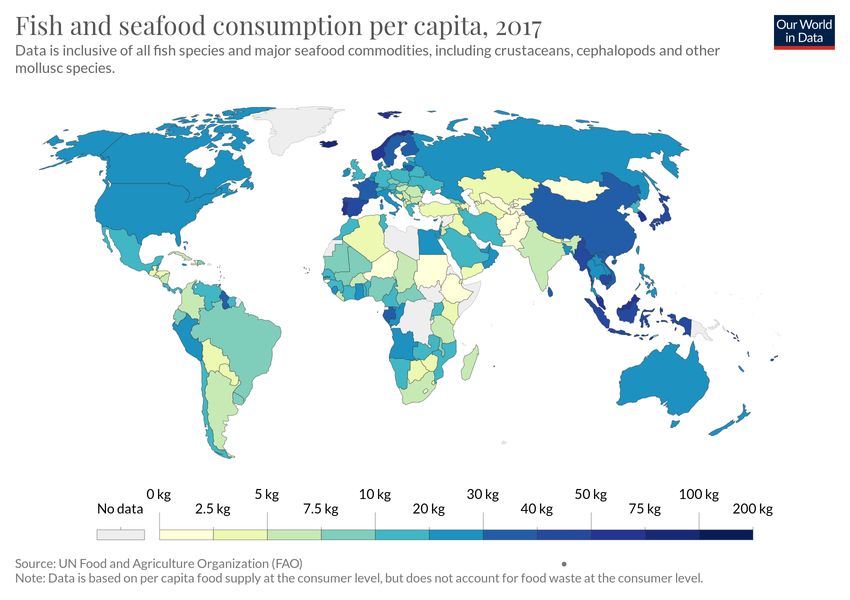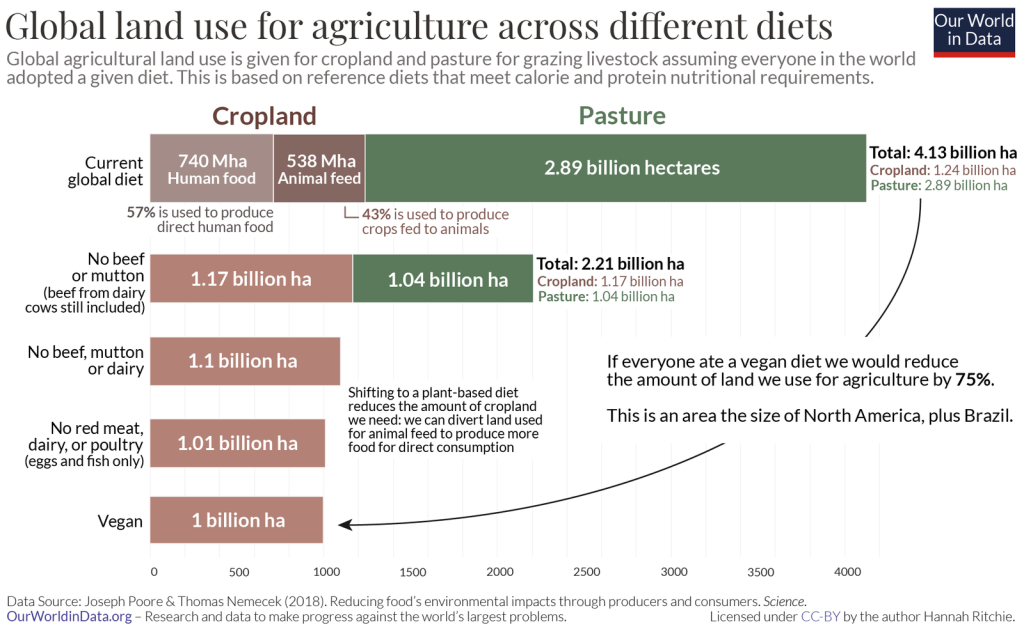— Anh NGUYEN
This article started as a personal struggle – being vegetarian and then moving to a coastal, fishing village in Brittany, France. The question was simple: which choice would leave more environmental footprints – eating cheese or sardines?
Instructions were not clear, ended up overfishing
According to a UN Food and Agriculture Organization report, 1/3 of commercial fish stocks are being harvested at biologically unsustainable levels, and 90% are fully exploited. At the same time, we have also heard that it is recommendable that “a healthy, balanced diet should include at least 2 portions (280g) of fish a week”.
That means 14,5 kg of fish per year per English man. This number is reflected in this chart – people in the UK consumed around 10 to 20 kilograms of fish per person in 2017. So, should an English man eat 2 portions (280g) of fish per week, or should he not? Or maybe the English people are not to blame, but countries such as China, Japan or Korea are catching and eating too much fish? (> 50kg per year per person)

An average person is probably quite well aware of the ugly consequences of fisheries on the marine ecosystem, namely:
- overfishing – some fish species are pushed to the point of population collapses or even extinctions, as shown here in this research paper (though in more recent research by French researchers, it is stated that overfishing leads to population collapses but rarely extinctions. Such a relief.)
- damages to the ocean floor (e.g. techniques such as bottom trawling where fishing nets are “dragged” along the seafloor to catch fish & shellfish – can destroy corals, sponges & habitats)
- bycatch (the unintentional catching of turtles, dolphins, or sharks – it is estimated that “300,000 small whales, dolphins, and porpoises die from entanglement in fishing nets each year”)


In this research paper “Reconstructing global marine fishing gear use”, the authors stated that the current techniques used in industrial fishing – i.e industrial bottom trawling – have led to “US$560 billion of wasted fish for the last 50 years”. These industrial fishing techniques generate “nearly 10 million tonnes of fish” being wasted as bycatch each year, and according to one of the authors, “the most wasteful way to do commercial fishing”.

We don’t know why bottom trawling is not yet banned everywhere – only around a dozen of countries have established some banned zones for bottom trawling, while Hong Kong, Indonesia, Palau & Balize banning this everywhere in their territories.
Besides signing petitions and waiting for several decades to pass by until the day wasteful fishing techniques become illegal everywhere, what are our options to alleviate the hidden monstrosity of our weekly sushi treat?
** Disclaimer: by “sushi treat” I mean the Westernised version of sushi sold everywhere now in the world – which is, in terms of gastronomy, a total “meh” instead of a treat. Regarding biodiversity, studies such as “sushi eaters pushing Pacific bluefin tuna to brink of extinction” do not make it sound very festive either.
** A (quite long) side note: To those of you who might say – does it mean we stop eating fish altogether? What kind of sad life is it? This reminds me of a discussion with a friend on inherent irreconcilable conflicts between wildlife and human life. The premise was that any dominant species, given enormous power over the rest of the ecosystem, will naturally maximize its presence and well-being, at the cost of the others. If another type of predator was to be a dominant species with superior strengths, humans would be eaten and wiped out, with no hard feelings. Like in the manga Blame!, the dominant species is the mechanical building robots whose sole purpose of their existence is to build and renovate structures, and therefore “consider” humans as unnecessary rats that must be exterminated, no hard feelings either. But I guess the difference is that humans constantly – or try to – make conscious choices. And because we do have feelings towards stuff, we want to continue to eat fish because it’s so good, but we also want to have fish in the sea for a longer-term benefit. So let’s try to make informed choices.
Alright, so what shall we have for dinner?
In terms of carbon intensity, pescatarians are legit when saying that the C02 emissions of eating fish are still way behind eating beef & lamb, while pollotarians can say sure, but then when I eat chicken, I’ll kill only one farmed species while emitting the same amount of C02.

In terms of land use and hence biodiversity on land (as a rule of thumb: the more land use for agriculture and pasture there is, the more forests and other natural zones need to be cleared out, the fewer habitats for animals and insects and the like), below is a comparison of different diets.

Interestingly enough, it says “if everyone ate a vegan diet we would reduce the amount of land used for agriculture by 75%”. Plus no animal suffering and more habitats for wild animals.
** A side note on animal suffering: this reminds me of an exchange in Star Trek – The Next Generation, Commander Riker said “We [humans] no longer enslave animals for food purposes. You’ve seen something as fresh and tasty as meat, but inorganically materialized, out of patterns used by our transporters.”. What a tempting world, but that’s human in the 24th century.
That’s about land use and all, but we don’t grow fish on land. How does eating fish and seafood impact biodiversity, compared to other diets? In this paper “Biodiversity impacts due to food consumption in Europe” (2019), the authors compare the impacts of each food product presented in the Basket of representative European products on biodiversity.

Seafood & fish is somewhere in the “other 24 products”. Interestingly enough, two years before this paper was conducted, seafood & fish were not even included in the representative food products in 2017. Why? Because, “these products [cocoa, palm oil, almond, tea, seafood] mainly come from trade, imported from developing countries”. Europeans ate €54 billion worth of seafood in 2015, coming second only to China in terms of consumption, and no it is not at all representative because it is “imported”. That’s neat. I admit I was having colonialism-PTSD reading this sentence.
Anyway, I didn’t find many research papers on the direct damage of fishing to marine biodiversity. However, many were on the next phase – the impacts of biodiversity loss on the marine ecosystem. There are 2 interesting ones, nevertheless:
- the “Global Assessment Report on Biodiversity and Ecosystem Services” by the UN in 2019 stated that overfishing is one of the five ways humans are accelerating the extinction of other species, hence biodiversity. (I invite you to read this article resuming the report to find out all 5 ways in which we are exterminating other lives on Earth)
- the research paper “Marine defaunation: animal loss in the global ocean”, states that “global rates of marine defaunation only intensified in the last century with the advent of industrial fishing and the rapid expansion of coastal populations”
So, let’s assume that there is a positive correlation between fishing (and overfishing) to marine biodiversity, roughly like this:

The question now is, if fishing contributes to marine biodiversity loss, should we farm fish instead? Like the way we farm cows and pigs and chickens instead of hunting them in the wild?
Sustainable fish farming: is there such a thing?
Aquaculture is on the rise now, while fisheries seem to reach a plateau.
Yet, aquaculture is receiving quite a few backlashes in recent years, with critics such as:
- Farmed fish are still being fed on ocean fish. For example, “4 kilograms of wild-caught forage fish to produce 1 kilogram of salmon”, which can look like a highly dumb problem
- Crowded conditions of fish farms can lead to diseases & pollution affecting the nearby natural marine zones
- Prawn cultivation in South & Southeast Asia has “contributed to the destruction of 38% of the world’s mangrove habitats”
I won’t dig deeper into the practice of farming salmons on land as seen in Miami, Florida, which will require much more energy & resources in order to maintain such a system, according to a study by Canada’s Fisheries Ministry on different salmon aquaculture technologies.

If we are resorting to this on-land fish farming, why don’t we go to the end of the exercise and create synthetic food & lab-grown meat? It would take pretty much the same amount of energy and trouble, but less of the dealing with living & sentient beings, wouldn’t it?
That being said, if done right, fish farming is supposed to be a more sustainable practice that secures our need to eat fish, isn’t it? In this article on National Geographic, the authors point out three interesting points:
- Feed conversion ratio: fish need fewer calories, and it takes roughly “a pound of feed to produce a pound of farmed fish” – 1:1, while it is 2:1 for chicken, 3:1 for pork, and 7:1 for beef.
- What’s in that “pound” to feed fish precisely, because 7 pounds of grasses require much lesser energy than 1 pound of captured tiny krill from Antarctica to feed farmed fish. Fish farmers are experimenting with new polyculture techniques (no surprise, learned from ancient China): feeding their fish with manure from ducks and pigs, creating cohabitation between fish & cockles & sea cucumbers & sugar kelp, etc. to produce extra food (and also profit).
- Eat farther down the food chain: learning to eat shellfish (mussels, oysters, etc.), or marine plants like kelp or seaweed is “key to sustainability”, which are also healthy products with rich nutrients and demand less care/energy/resources to sustain.
This point this the most interesting, in my opinion. The cuisine heritage we inherit from our forefathers is heavily based on animals that are pretty up the food chain – either because we learned to hunt or farm them.
The less apparent options are food down the food chain – things we didn’t (have to) learn to hunt, gather or cook. According to researchers at Arizona State University, “shellfish was one of the last additions to the human diet before domesticated plants and animals were introduced”, and played a vital role in the survival of early man. This resonates with the opinion of a researcher at the University of York – “Our data shows that at a time when many other resources on land were scarce, people could rely on their locally available shellfish.“
If early man learnt to eat further down the food chain when necessity arose, can we also learn this, to halt the increasing biodiversity loss rate?


Eating farther down the food chain – insects & shellfish as now our primary source of protein? Photo source.
** A note on biodiversity: I mentioned a lot of “biodiversity” in this article, but why should we care? Some of the answers can be found here in this article “What is biodiversity and why does it matter to us?”, which I invite you to take a look.
RELATED ARTICLES
Forest garden or edible garden: a quick and practical guide to the concept


2 thoughts on “Overfishing: there will no longer be plenty of fish in the sea. What are our alternatives?”